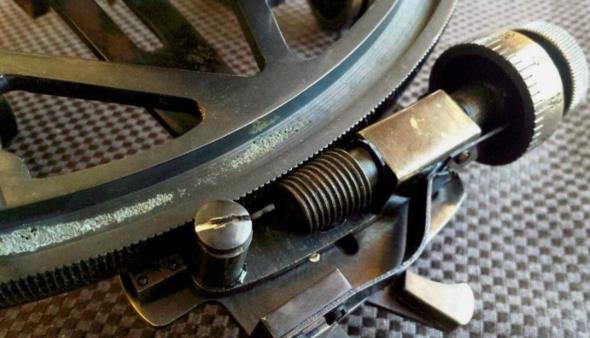
NavList:
A Community Devoted to the Preservation and Practice of Celestial Navigation and Other Methods of Traditional Wayfinding
From: Frank Reed
Date: 2018 Jul 16, 09:52 -0700
Jim, you wrote:
"I have always been curious if there is any functionality to these faux sextants. I have never had an opportunity to actually handle one but from some of the pictures I have seen, some look quite detailed.
Are they capable of being used to take any kind of sight?"
Right? They do look like they ought to work in some fashion, don't they? So far, however, I have not encountered one that even comes close. Usually, you'll find some small but insurmountable practical problems like sun shades that are not even remotely dark enough when used together to block the light of the sun, or a telescope that is blocked by the index mirror frame. It seems as if these small issues might be fixed with a little work, but there are more subtle and serious problems.
Thre are two elements of modern sextants that require especially careful manufacture which we don't often recognize. First, the index arm's axis of rotation --that central turning point behind the index mirror-- has to be exactly centered in the sextant's arc, and it needs to be quite stable. This is expensive, and it's something that would never make its way into the design process for a sextant that merely "looks right". However, if this could be managed, perhaps by retrofitting a rotation axis from another bit of tech, there would still be another problem --at least for micrometer sextants. Micrometer sextants have a second feature that requires precise machining, and that's the milling of the arc. All those gear teeth on the arc that the micrometer worm gear seats into have to be placed and cut with exacting precision. All the accuracy of a modern sextant depends on this. Since these faux sextants only have those teeth placed for appearances, they yield poor accuracy.
The sextant in question also has been manufactured apparently from molded metal, simple castings. In the photo attached below from the auction, you can see that the teeth on the arc look as if they're "chewed up". Also the teeth on the worm gear of the micrometer have "dull" edges. I doubt that the worm gear would even seat in the teeth along the arc, let alone measure anything in a useful way.Notice also in the photo that there are funny grey "growths" that look like some sort of corrosion on the back of the arc. Are they growths? Or hollows? Those to me look like hollows or "pitting" left behind when the frame was molded, just places where the molten metal failed to fill in completely during the casting process. It seems likely that the whole frame, including the teeth on the arc were cast from a mold. The mold can resemble the teeth of a sextant arc but cannot approach the precision of a milled arc.
By the way, this whole issue of the milling of the arc highlights a radical though almost invisible change in the creation of accuracy in a sextant. For the first 160 years or so of the history of sextants, the exact cutting of the scale on the sextant arc was critical to accuracy. Dividing engines were invented and perfected so that those finely drawn lines on the arc of a vernier sextant would fall at exact angular intervals. On a modern micrometer sextant, the degree lines on the arc of a sextant require far less careful placement. That problem of dividing the arc has been transferred to the problem of milling the teeth of the arc. This process demands high-quality, expensive manufacturing. It will never happen by incremental enhancement in the cosmetic appearance of these novelty sextants.
How about a vernier sextant? Has anyone experimented with a faux (novelty) vernier instrument? Imagine combining the basic attention to accuracy found in a Davis Mk III sextant with the cosmetic "shiny" details of one of these coffee table mockups. That might work!
Frank Reed







